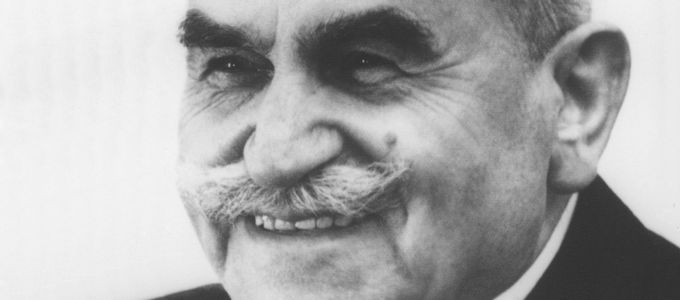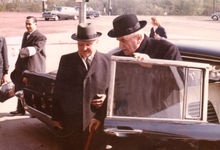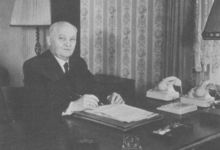The story of the man who was Chief Apostle for 30 years
These were difficult times in the history of the New Apostolic Church. They included two world wars, internationalisation, consolidation, division, and realignment—a little bit of everything. And he stood firm like a rock in the pounding surf: Chief Apostle Johann Gottfried Bischoff was born 150 years ago today.

Every person has a right to private life—and Johann Gottfried Bischoff was no exception. He was born on 2 January 1871 in Unter-Mossau, a small, rural, and idyllic village nestled in a forested region in Germany’s southern Hesse. To this day, his name appears in the corresponding registers as a personage who was known far beyond the borders of his local village. His childhood was marked by poverty and constraints, but it was precisely because of this that he developed the stamina he would one day need in order to endure unpleasant days. Of course, with eleven siblings, an apprenticeship as a shoemaker, and some agricultural work on the side, it did not seem likely that he would make great strides in life.
The Church leader
It was in Easter 1897 that he attended a New Apostolic divine service for the very first time. His close relationship with God and his neighbour defined his activity in God’s work from the start. Already as a Deacon, he conducted many divine services. As a Priest, he travelled to congregations in Wiesbaden, Frankfurt, Kassel, and Eisenach. In the year 1903 he was already ordained a Bishop, and then ordained an Apostle only three years later.
Starting in 1920 he worked as a Chief Apostle Helper at the side of Chief Apostle Hermann Niehaus. In 1930 he took on the leadership of the New Apostolic Church—which had since become an international organisation—and then went on to lead it for the next 30 years. Until the year 1960 he decided over the fate of a steadily growing global Church that was at times also confronted with the challenges of politics and geography, and which initially shied away from ecumenism as it struggled to reconsider some of the core points of its doctrine.
The defender and innovator
There were many conflicts and grievances within the Church itself, which led to the emergence of other apostolic denominations that have followed different paths over the years. There were disputes with the Nazi regime, the Gestapo, extreme racists, not to mention anti-Semites and Christian haters. These were times of fundamental theological decisions, especially with regard to questions surrounding the apostolicity of the Church. So it was that the young Apostle Bischoff already resisted the so-called “Doctrine of the new light”. One of his views was: “It is delusional to believe that Jesus only dwells in the flesh of the Apostle.” Another argument recorded in a letter from Johann Gottfried Bischoff to Carl August Brückner read: “It happens all too often that the one who is sent receives greater glory than his Sender. And we must work to ensure that the Lord—as the foundation and chief cornerstone—is finally accorded His rightful place in Hiswork.”
The confidante
His words had weight and always bore consequences. Over time he became a closer and closer confidante of the then Chief Apostle Hermann Niehaus, which on the other hand led to personal upheavals between himself and Brückner—two Apostles who could not have been any more different from one another. One remained in the Church, the other left. In December 1924, Chief Apostle Niehaus appointed Apostle Bischoff as his successor. The Saxon Apostle Carl August Brückner would certainly also have been a contender for this task, but he had already been excommunicated from the Church in April 1921. He went on to establish the Reformiert-Apostolische Gemeindebund [federation of Reformed Apostolic Congregations] which is today part of the United Apostolic Church.
As Chief Apostle, Johann Gottfried Bischoff initiated numerous changes—some minor, some major—in the liturgical sequence of the divine services, scheduled divine services for the departed three times each year, introduced children’s services on a district level, and personally toured the congregations in North America. Even the first transmission of services can be traced back to his leadership: it was in 1946 that the first divine service of this kind took place, emanating from the New Apostolic congregation in Reutlingen. In 1956, his divine service in Frankfurt am Main was already transmitted to 321 congregations connected by post cable.
The Chief Apostle
When the name Johann Gottfried Bischoff is mentioned today, many people are quick to recall the days of the Botschaft (the message that Jesus Christ was going to return prior to the Chief Apostle’s own death) and the resulting schism in the Church. Nevertheless, the Chief Apostle’s lifetime accomplishments amount to much more than that. Being a Chief Apostle is certainly not just a matter of Statutes. His unshakeable faith, his internalisation of the Apostle ministry, his enduring definition of doctrinal content—some of which still defines the New Apostolic Catechism to this day—are all part of the extensive repertoire of this servant of the Church. As such, he survived two World Wars, internationalised, consolidated, and realigned the young Church. He suffered all his life as a result of the separations that had occurred in his time.
On 6 July 1960 he died in Karlsruhe.






